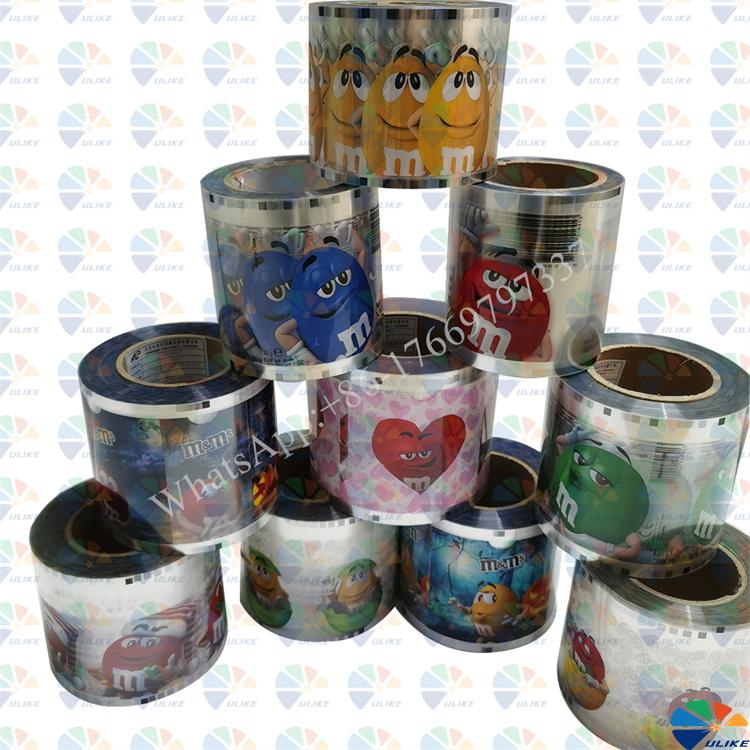Concept of Cosmetic Thermal Transfer Film
1. Concept of
Cosmetic Thermal Transfer Film
Cosmetic thermal transfer film is a decorative film applied to cosmetics. It is mainly designed, laid out, and transferred on the surface of cosmetics such as powder boxes, moisturizing cream jars, lipstick shells, eyebrow pencil packaging, mascara shells, blush bottles, moisturizing water bottles, etc. It is very common in daily life.
Lipstick Cosmetic Thermal Transfer Film
2. Material of Cosmetic
Thermal Transfer Film
Cosmetic thermal transfer film uses a transparent film as the base film, and its material can generally be divided into three types:
A. OPP: large elasticity, large punching pressure, but poor high temperature resistance.
B. PET: small elasticity, good stability, the most widely used of the three, accounting for about 80% of the product base film.
C. PVC: The material is extremely versatile, corrosion-resistant, good insulation, and has a small molding temperature range.
3. Hot stamping temperature of cosmetic thermal transfer film
During the processing of cosmetic thermal transfer film, since cosmetics are composed of a variety of materials, different hot stamping temperatures need to be adjusted for different product materials.
For example, the hot stamping temperature of PE material is 220℃-260℃;
The hot stamping temperature of EVA and PVC materials is 140°C-160°C;
The hot stamping temperature of ABS material is 180°C-200℃;
The hot stamping temperature of PC material is 160℃-200℃;
The hot stamping temperature of the cosmetic surface of metal material is about 220℃-270℃;
The surface strength of PP is relatively high, so when we make the transfer printing film, we need to adjust the pressure and temperature higher, and the temperature is generally controlled at 240℃-260℃
4 Design principle of cosmetic thermal transfer film
Its design principle is to design the artwork and layout according to the unfolded area after the shape of the cosmetics (powder box, moisturizing cream jar, lipstick shell, eyebrow pencil outer packaging, mascara shell, blush bottle, moisturizing water bottle) is unfolded.
When calculating the unfolded area, the "shrinkage" of the cosmetic product and the "stretching" of the thermal transfer film should also be estimated. This way, the actual printing area of the cosmetics can be accurately calculated, thereby designing accurate thermal transfer graphics.
![af]() Afrikaans
Afrikaans![sq]() Albanian
Albanian![am]() Amharic
Amharic![ar]() Arabic
Arabic![fr]() French
French![es]() Spanish
Spanish![ru]() Russian
Russian![de]() German
German![hy]() Armenian
Armenian![it]() Italian
Italian![ja]() Japanese
Japanese![ko]() Korean
Korean![pt]() Portuguese
Portuguese![hi]() Hindi
Hindi![az]() Azerbaijani
Azerbaijani![ro]() Romanian
Romanian![pl]() Polish
Polish![th]() Thai
Thai![el]() Greek
Greek![eu]() Basque
Basque![en]() English
English![zh-CN]() Chinese (Simplified)
Chinese (Simplified)![zh-TW]() Chinese (Traditional)
Chinese (Traditional)![be]() Belarusian
Belarusian![bn]() Bengali
Bengali![bs]() Bosnian
Bosnian![bg]() Bulgarian
Bulgarian![ca]() Catalan
Catalan![ceb]() Cebuano
Cebuano![ny]() Chichewa
Chichewa![co]() Corsican
Corsican![hr]() Croatian
Croatian![cs]() Czech
Czech![da]() Danish
Danish![nl]() Dutch
Dutch![eo]() Esperanto
Esperanto![et]() Estonian
Estonian![tl]() Filipino
Filipino![fi]() Finnish
Finnish![fy]() Frisian
Frisian![gl]() Galician
Galician![ka]() Georgian
Georgian![gu]() Gujarati
Gujarati![ht]() Haitian Creole
Haitian Creole![ha]() Hausa
Hausa![haw]() Hawaiian
Hawaiian![iw]() Hebrew
Hebrew![hmn]() Hmong
Hmong![hu]() Hungarian
Hungarian![is]() Icelandic
Icelandic![ig]() Igbo
Igbo![id]() Indonesian
Indonesian![ga]() Irish
Irish![jw]() Javanese
Javanese![kn]() Kannada
Kannada![kk]() Kazakh
Kazakh![km]() Khmer
Khmer![ku]() Kurdish (Kurmanji)
Kurdish (Kurmanji)![ky]() Kyrgyz
Kyrgyz![lo]() Lao
Lao![la]() Latin
Latin![lv]() Latvian
Latvian![lt]() Lithuanian
Lithuanian![lb]() Luxembourgish
Luxembourgish![mk]() Macedonian
Macedonian![mg]() Malagasy
Malagasy![ms]() Malay
Malay![ml]() Malayalam
Malayalam![mt]() Maltese
Maltese![mi]() Maori
Maori![mr]() Marathi
Marathi![mn]() Mongolian
Mongolian![my]() Myanmar (Burmese)
Myanmar (Burmese)![ne]() Nepali
Nepali![no]() Norwegian
Norwegian![ps]() Pashto
Pashto![fa]() Persian
Persian![pa]() Punjabi
Punjabi![sm]() Samoan
Samoan![gd]() Scottish Gaelic
Scottish Gaelic![sr]() Serbian
Serbian![st]() Sesotho
Sesotho![sn]() Shona
Shona![sd]() Sindhi
Sindhi![si]() Sinhala
Sinhala![sk]() Slovak
Slovak![sl]() Slovenian
Slovenian![so]() Somali
Somali![su]() Sudanese
Sudanese![sw]() Swahili
Swahili![sv]() Swedish
Swedish![tg]() Tajik
Tajik![ta]() Tamil
Tamil![te]() Telugu
Telugu![tr]() Turkish
Turkish![uk]() Ukrainian
Ukrainian![ur]() Urdu
Urdu![uz]() Uzbek
Uzbek![vi]() Vietnamese
Vietnamese![cy]() Welsh
Welsh![xh]() Xhosa
Xhosa![yi]() Yiddish
Yiddish![yo]() Yoruba
Yoruba![zu]() Zulu
Zulu


